Asexuality as Obfuscation in Anime: Yuri on Ice
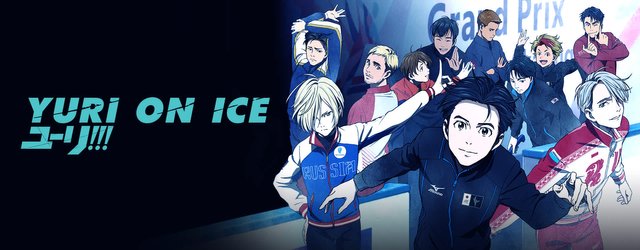
- Source: Funimation
Advisory: While I’m not going NSFW on this one, there will be discussion of mature subjects.
Homosexuality is rarely covered in anime, even less so for homosexual male characters. When they are shown they’re often flaming stereotypes, but even in yaoi/shonen-ai works, homosexuality is often heavily implied, but never said outright. When it is, it’s usually treated in the same manner as it is commonly in American/Western Romance.
M/M, GFY, and Erasure
Let’s start with a primer, so that the uninitiated and unaware can get some context to catch up, because the issue is rather niche, when you think about it.
M/M and M/M Romance
M/M is a fetish tag. It’s important to start with that. It stands for male/male, and the slash has its own implications as well, namely that erotic, though not necessarily graphic and/or sexual, content will be contained therein. Primarily used in fanfiction and erotic fiction, it was a simple tag to use when combing through story offerings to inform the reader if the content was or wasn’t what they were looking for. Romance was a tag as well, implying that the work would focus primarily on the emotional love rather than the physical. M/M Romance sprang up as a genre in Romance fiction, primarily driven by (mostly white) heterosexual women as writers, editors, publishers, reviewers, and readers, and as a result was targeted primarily at that audience to its tastes: 18-29, white or white-passing, slightly androgynous, attractive (obviously), and sexually forward.
GFY
GFY means “gay for you”, and that means that one, or both men in the pairing would never consider homosexual contact with any other man that the one that they’re currently with. Usually, they’re set up as having had girlfriends in the past, or currently dating, and otherwise assumed straight. When the possibility of romance does occur, the romantic lead will often make a point of mentioning that they didn’t fall in love with the other person’s gender, but the person themselves. It’s a noble sentiment, but it implies that any other person of the same gender would not be attractive to them. "Gay for you" usually involves a "sexual awakening", where the lead feels an attraction they'd never felt so potently.
Erasure
“Gay for you” has been criticized in the romance and bisexual community for its issues of bi-erasure, or filtering homophobia through a romance-friendly lens. This is done not just in romance, but also in other media formats as comics, graphic novels, television, and film. The driver seems to be exposure: the more popular it is, the more likely that a previously bisexual character will gravitate to one end of the Kinsey Scale. (The Kinsey Scale has its own issues, now replaced by the more complex spectrums that include facets for queerness, asexuality, and pansexuality.) This is evident in Torchwood, where fan favorite Jack begins the series as bisexual, but becomes exclusively gay as the series proceeds, or in Legends of Tomorrow, where Sara Lance begins the series as bisexual, but is only shown having sexual or romantic relationships that are same-gender. Implied asexuality and celibacy are methods of erasure as well, used not only to avoid any suggestion of mature or “controversial” material, but also to misinform about asexuality as well.
And Then There’s Anime
Anime does not have a good track record for LGBTIQA+ representation. Supporters will quickly admit that it’s a cultural aspect, but an examination of Japanese history will reveal that said cultural aspect was influenced heavily by Western nations. Bisexuality is thoroughly erased, and homosexual relationships are largely limited to comedies when they’re shown at all. This is largely why Yuri on Ice! Drew so much attention.
Shonen-ai and yaoi (M/M romance) in anime isn’t anything new. There are a few here and there, most notably Gravitation, which put a same-sex relationship between two men at the center of the plot (though Gravitation grows increasingly ridiculous in its plot points as the series progresses), but any sexual contact remains implied. It also clung tightly to a “gay for you” storyline between the two leads, having scenes that had characters implicitly stating that they didn’t fall in love with a man, but with another person.
Sex is never really implied to have been had in Gravitation, save in a scene where the romantic lead is nearly gang raped for having a more successful album single and little else. Plenty is implied about the romance between the two characters, and the trials and hardships for the two to move forward, but largely, the physical part of the relationship is accomplished through “pan to the closing of the door” shots that imply sex, but there’s no aftermath, and sex is never really discussed between the pair, or talked about with other characters. It’s erasure, first because Gravitation goes out of its way to remove sexuality from the homosexual relationship, making it homoromantic, and safe to sell.
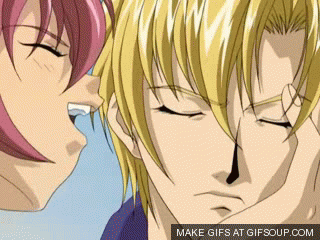
Why bring up Gravitation? Because it establishes a precedent, a template for how a homosexual relationship is to be written and shown in wide-release anime: if two men are in a relationship, it is sexual even if it is not shown, there is no possibility that either are bisexual, and definitely not on any other part of the spectrum, which I believe that is a template that viewers apply to Yuri on Ice!
Yuri on Ice!/is Ace?
Yuri on Ice! would normally be considered a “sports” anime, as it centers around athletic competition, in this case men’s figure skating. While there are comedic elements, it hits many of the sports tropes with the “comeback” character to provide exposition, the aging star who becomes a mentor figure, a brash prodigy who serves as a rival, and an assortment of supporting cast to provide additional conflict. The story follows the normal Hero’s Ascent path, with the protagonist climbing from the bottom to reach the top, and competing against world class athletes where he will be the underdog, but triumph in some way at the end.
What set it apart was the implied homosexual relationship between Yuri, the protagonist, and his mentor/coach/idol, Victor. Throughout the series the relationship develops, a same-sex kiss is implied to have happened on national TV, and close to the finale a heavily implied marriage/engagement occurs between the two, with the final credits played over Yuri and Victor performing on ice in a pair to a romantic composition.
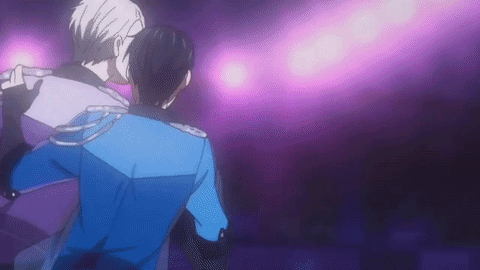
The development between the two is played as implying GFY, as with most anime, and as it generally follows the template set by Gravitation and those before it, it could be seen that Yuri on Ice! is of the same variety, though other implications lie in the background, and in the telling. To begin, it can be said that Yuri is actually what Gravitation and its ilk used to imply homosexuality, in that Yuri could be seen as a homoromantic asexual. (A person who forms, and prefers romantic relationships with those of the same gender, but does not or very rarely engages in sexual contact. Also, a few have clocked Yuri as demisexual, which is definitely possible, as well.)
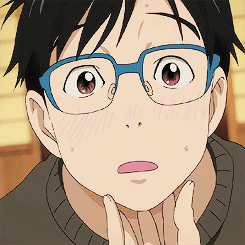
Katsuki Yuri is a 23-year old Japanese figure skater who first sees Victor skating on national TV as an adolescent, and immediately develops a crush/falls in love with him. He dedicates himself to copying Victor on the ice, gets a dog like Victor’s, and pushes himself to become a top skater so that he could compete against, and possibly surpass Victor on the ice. Upon prodding by Victor, he reveals that he’s never had a girlfriend, and likely is still a virgin. When assigned a routine to “On Love: Eros”, an intensively seductive sequence based around sexual love, Yuri needs a whole episode to figure out what exactly sexual love means, which he chides himself for, as a 23 year old man should understand what sexual love is.
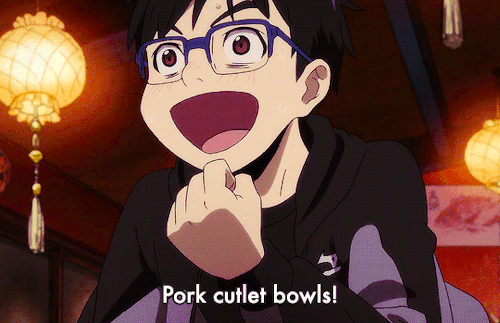
It’s also suggested in his rejections of Victor, as whenever it grows physical, Yuri “runs away”, or backs off, as the implication is a sexual advance. However, the more romantic gestures of taking each other’s hand, wanting to be the center of the other’s attention, hugging, even the implied kiss, imply not sexual love, but romantic love. His admiration for Victor, as well as his own personal repression, and self-doubt could be attributed to the relationship developing in ways similar to the Gravitation model, but even as the series progresses, one thing must be kept in mind: There is never implied sexual contact, though the romantic contact becomes more common.
The closeness between the characters, both platonically and romantically, how they learn each other’s behaviors and quirks implies that a romantic relationship will develop, but not a sexual one (despite Victor’s repeated offers of such). The difficulty of separating romantic love and sexual love isn’t an uncommon issue, because all too often romantic love and sexual love walk hand in hand so often they’re assumed to be synonymous. However, there are multiple occasions where Victor offers to be Yuri’s lover, and is shot down or declined, even when it’s apparent that they’re together and committed to each other. That Victor offers so casually to be Yuri’s lover so many times implies that either the attraction is mutual, that Victor has been free with his sexual love in the past, or both.
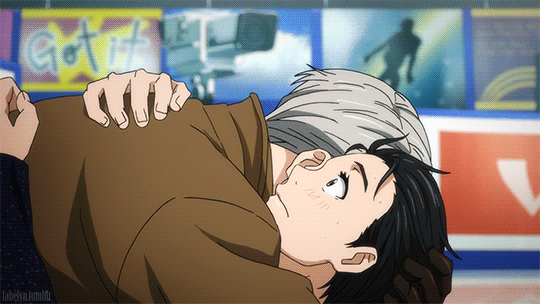
Yuri is in romantic love with Victor, seeking a deeper commitment that he seals with vows and a golden ring, but even after the “marriage” in Barcelona, no sex takes place. Romantic love with someone of the same gender, but a displayed and spoken want to not engage in sexual contact. This is the definition of homoromantic asexuality.
Why This Matters
Katsuki Yuri, despite the above, is largely assumed by the fans to be gay. Why? The story checks all of the boxes for a quick run-through: Yuri is over 20 and has never had a girlfriend, he’s been fixated on another man he’s idolized since childhood, there’s an implied kiss and marriage with another man, and sex is not shown in anime, especially not between two men if not being played for comedy. If a viewer wasn’t paying close attention, or was unaware of the sexual spectrum outside of the Kinsey Scale, it would be an easy, and generally safe assumption that Yuri is homosexual.
Human sexuality is so complex that we’ve developed spectrums within spectrums within spectrums, and it still doesn’t quite contain everything in the + after LGBTIQA. When anime establishes a formula and template for portraying gay characters by only using story traits that asexuals have in common with gays, it can result in aces being incorrectly labeled as gay, and further supports the false assumption that sexuality is a binary trait: hetero or homosexual, with everything else obfuscated.
What this does is foster ignorance regarding identity, that a character like Victor who enjoyed portraying himself androgynously in his teens would be seen as gay, not as a young man experimenting with gender identity and gender fluidity, or that Yuri, who has been in love with Victor since adolescence, must be homosexual and therefore sexually interested in Victor, obfuscating the possibility that his feelings toward him are purely romantic, and not sexual at all. By allowing the characters to be read in more diverse ways, it encourages more representation, for viewers to possibly see themselves in the traits. (E.g. When Todd came out as asexual in BoJack Horseman, there was an uptick of searches for local asexual groups and alliances, as many researched if they themselves were on the spectrum.)
Representation isn’t the only goal, though. By ascribing so many asexual traits to Yuri and marketing the series as a “sexual awakening”, it implies that, much as with “gay for you”, that Yuri was only asexual because he never considered that he had been gay all along, and that luckily, he could be “fixed” by Victor’s love. This furthers the idea held that if you’re sexually mature, you should be seeking sexual contact, and if you aren’t, there is something wrong with you that needs to be “fixed”. By pushing that reading/viewing of Yuri on Ice!, it enforces not only sexual normativity, it also feeds into the insecurities that many asexuals have before coming out: that they aren’t “wired right”, and need to be “fixed”.
But Yuri, and other asexuals, are wired just fine. They don’t need to be fixed. They can love, either romantically, platonically, or both, and are deserving of the same.
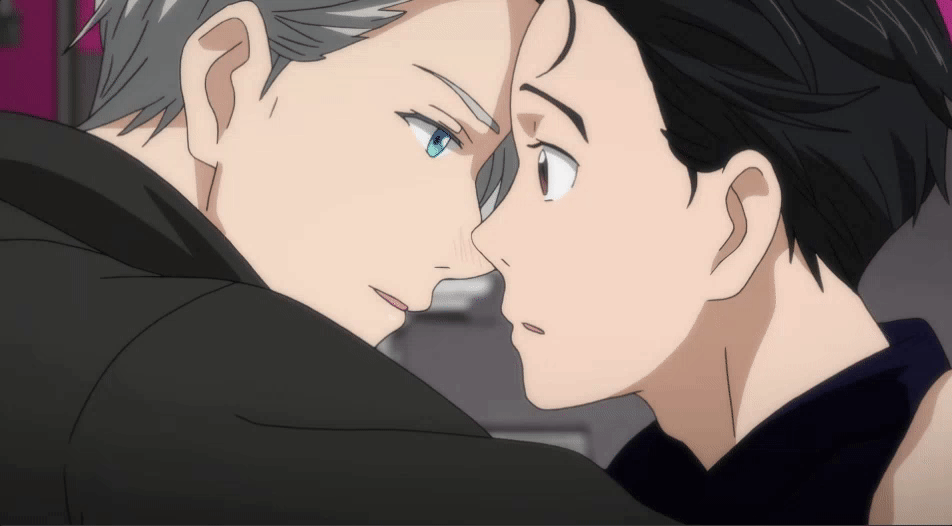
I personally never get the argument that people should all have representation in media. I'd never look at an anime and ask where my Vietnamese representation is because immersion is almost all that I care about in movies and TV. I personally forget that the real world exists and I become nothing more than an observer of this fictional world. I've talked to people about it before, but I've never been convinced of why it matters.
Although, within the context of anime specifically, I felt similarly to what you've mentioned here in the show, "Miss Kobayashi's Dragon Maid". In that show, Kobayashi played a somewhat similar asexual role as Yuri does in YoI, while Tooru makes attempts at fostering a more intimate relationship.
Kobayashi says that she isn't used to be loved and cherished by people and that she needs more time to get to grips with it. I don't think the message is that asexuality, in this case, is a bug that needs to be fixed. More so that Kobayashi simply grows to appreciate Tooru's presence in her life over time.
It's framed through silly, fantasy, comedy elements, but if you distill their interactions over the course of the show to their core, I feel Kobayashi was one of the best depictions of a lesbian relationship in anime. Not that that's exactly the highest bar ever, but take it for what it is.
Certainly better than Bubblegum Crisis, yes. :)
Maid-chan thinks this is a good analysis and has resteemed the post!